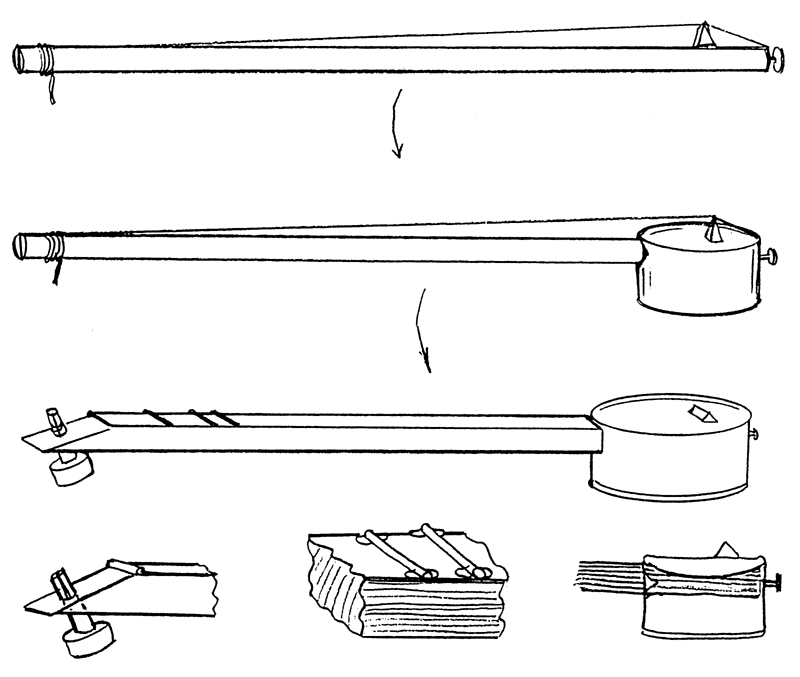
The Tuna-Tin Banjo
Ellen Kuhfeld
Who says you can tune a banjo, but you can't tuna fish? This one is both very real, and very silly. After people meet it, they can never again hold stringed instruments in quite the same awe. It's simply a neater version of the mouth-bow with a tuna can at one end.

You need a piece of straight wood, 28" long and 3/4" square. Hardwood is more durable. One side has to be very straight -- use a ruler to make sure it is. You will put frets on that side. Cut the fret side down by 1/8" for 3-1/4" back from one end. Hollow out the middle another 1/8". Measure 2-1/2" from the other end, and cut the stick off at an angle. Drill a 1/4" hole in the angled end. (See drawing.)
Whittle a tapered peg to fit in the hole. It will be your tuning peg. Sand its shaft round and smooth.
Mark the cross-section of your piece of wood on one side of the tuna can. Punch a hole in the middle of the marks, and cut out to the corners with a tough sharp knife. Hold the can flat on a workbench while you cut towards the bench. If you should slip, better to cut the workbench than your hand! Push the cuts in the can open, and shove the stick into the hole. Pound a nail through the can into the stick. Leave the head of the nail a bit free of the can. It will hold the can in place, and you can fasten one end of the string to it.
Push your peg into the hole, and twist it back and forth until it sits comfortably. Drill a 1/16" hole about 1/8" above the stick's surface. Tie a loop in one end of a yard of line, and hook it around the nail. (This instrument sounds best with a metal string -- a banjo second string is ideal, and comes with the loop already in one end.) Push the other end through the peg, and tighten the string by turning the peg. Take a piece of triangular wood 3/8" high. Cut a small notch in one edge, and use it as a bridge to hold the string above the can.
The banjo sounds okay, but there is no easy way to get an exact note. Frets would make it easier to play melodies. I make frets by cutting paper clips to get bits of straight wire, 5/8" long. I mark off where I want the frets and put a drop of glue on each end of the fret line. Then I drop the pieces of wire onto the line and let the glue harden. Put one piece of wire right where the angled end of the stick meets the flat surface. Pound a nail in the center of the angled surface, just 1/8" from the wire. (This nail positions your string to go down the center of the stick.)
Use a metric ruler to mark fret positions at
6.6 - 12.4 - 15.1 - 20.0 - 24.3 - 26.3 - 30.0 - 33.3 - 36.2 - 37.5 - 40.0 - 42.2 centimeters
from the wire where the angled end meets the flat surface. (I've included a short computer program to calculate fret positions for any length of string.) I don't use all the frets -- just the "white keys". It is easier to play tunes.
When the frets are glued in place, put the string back on and tighten it. Use epoxy glue to fasten the bridge to the tuna can with its notch 60 centimeters away from the first wire -- the one between the straight and the angled sections.
Next: The Nicotina